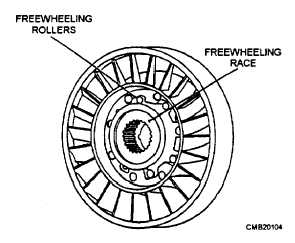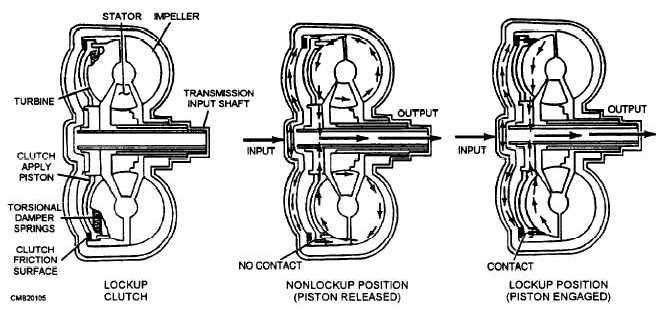
Figure 4-27. - Stator assembly.
off the stator vanes at tremendous speeds. The greatest torque multiplication occurs at stall speed.
When the turbine speed nears impeller speed, torque multiplication drops off. Torque is increased in the converter by sacrificing motion. The turbine spins slower than the impeller during torque multiplication.
If the counterclockwise oil were allowed to continue to the center section of the impeller, the oil would strike the blades of the pump in a direction that would hinder its rotation and cancel any gains in torque. To prevent this, you can add a stator assembly.
The stator (fig. 4-27) is located between the pump and the turbine and is mounted on a one-way clutch that allows it to rotate clockwise but not counter- clockwise. The purpose of the stator is to redirect the oil returning from the turbine and change its rotation back to that of the impeller. Stator action is only needed when the impeller and turbine are turning at different speeds. The one-way clutch locks the stator when the impeller is turning faster than the turbine. This causes the stator to route oil flow over the impeller vanes properly. Then, when turbine speed almost equals impeller speed, the stator can freewheel on its shaft so not to obstruct flow.
Even at normal highway speeds, there is a certain amount of slippage in the torque converter. Another type of torque converter that is common on modern vehicles is the lockup torque converter (fig. 4-28). The lockup torque converter provides increased fuel economy and increased transmission life through the elimination of heat caused by torque converter slippage. A typical lockup mechanism consists of a hydraulic piston, torsion springs, and clutch friction material.
In lower gears, the converter clutch is released. The torque converter operates normally, allowing slippage and torque multiplication. However, when shifted into high or direct drive, transmission fluid is channeled to the converter piston. The converter piston pushes the friction discs together, locking the turbine and impeller. The crankshaft is able to drive the transmission input shaft directly, without slippage. The torsion springs assist to dampen engine power pulses entering the drive train.

Figure 4-28. - Torque converter with lockup clutch.
Continue Reading